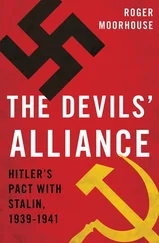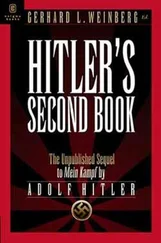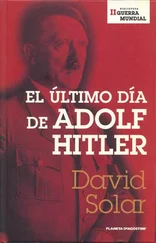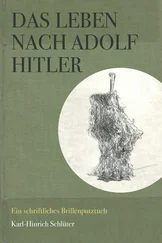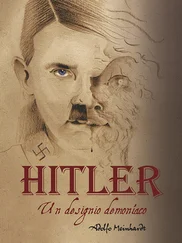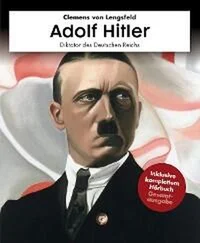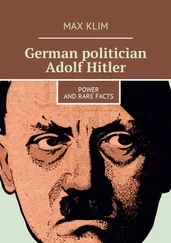Christa Schroeder - He Was My Chief - The Memoirs of Adolf Hitler's Secretary
Здесь есть возможность читать онлайн «Christa Schroeder - He Was My Chief - The Memoirs of Adolf Hitler's Secretary» весь текст электронной книги совершенно бесплатно (целиком полную версию без сокращений). В некоторых случаях можно слушать аудио, скачать через торрент в формате fb2 и присутствует краткое содержание. Город: Barnsley, Год выпуска: 2012, ISBN: 2012, Издательство: Frontline Books, Жанр: История, Биографии и Мемуары, на английском языке. Описание произведения, (предисловие) а так же отзывы посетителей доступны на портале библиотеки ЛибКат.
- Название:He Was My Chief: The Memoirs of Adolf Hitler's Secretary
- Автор:
- Издательство:Frontline Books
- Жанр:
- Год:2012
- Город:Barnsley
- ISBN:978-1-7830-3064-4
- Рейтинг книги:4 / 5. Голосов: 1
-
Избранное:Добавить в избранное
- Отзывы:
-
Ваша оценка:
- 80
- 1
- 2
- 3
- 4
- 5
He Was My Chief: The Memoirs of Adolf Hitler's Secretary: краткое содержание, описание и аннотация
Предлагаем к чтению аннотацию, описание, краткое содержание или предисловие (зависит от того, что написал сам автор книги «He Was My Chief: The Memoirs of Adolf Hitler's Secretary»). Если вы не нашли необходимую информацию о книге — напишите в комментариях, мы постараемся отыскать её.
He Was My Chief: The Memoirs of Adolf Hitler's Secretary — читать онлайн бесплатно полную книгу (весь текст) целиком
Ниже представлен текст книги, разбитый по страницам. Система сохранения места последней прочитанной страницы, позволяет с удобством читать онлайн бесплатно книгу «He Was My Chief: The Memoirs of Adolf Hitler's Secretary», без необходимости каждый раз заново искать на чём Вы остановились. Поставьте закладку, и сможете в любой момент перейти на страницу, на которой закончили чтение.
Интервал:
Закладка:
36
Hitler issued his ‘Basic Order’ respecting secrecy on 25 September 1941. This was published to all military and Reich centres by the interior minister on 1 December 1941. Part I prescribed: ‘Nobody, no centre, no official, no employee and no worker may know of any secret matter which it is not absolutely necessary for that person to know in the course of his or her duty.’
37
Hitler attended the wedding ceremony with Göring on 28 June 1934 and afterwards visited the Krupp works at Essen.
38
In March or April 1933 Hitler formed a ‘Police Commando for Special Purposes’ headed by Johann Rattenhuber, a lieutenant in the Bavarian provincial police force and from 10 March 1933 adjutant to Himmler as president of police. The squad, all from Munich, was eight strong and worked alongside Hitler’s bodyguard, the SS-Begleitkommando . By 1944, designated RSD (Reich Security Service) it had grown in size to 250 men.
39
Hitler’s driver Erich Kempka stated postwar that Hitler went to Bad Wiessee with his staff and the police commando only. The SS-Begleitkommando was left in the dark, a fact of which they took a dim view.
40
On 30 June 1934 at Stadelheim prison, Munich, the SA leaders Uhl, von Spretti, Heines, Hayn, Heydebreck, Schneidhuber and Schmidt were shot. Other executions followed next day at Dachau concentration camp and elsewhere. The official list has eighty-three names, but the actual number of victims was greater.
41
Max Wünsche (b. 20.4.1914 Kittlitz, d. 17.4.1995 Munich). 10.7.1933 joined LSSAH; 25.4.1935◦– 31.3.1936 SS-Junker School at Bad Tölz; 20.4.1936 SS-Untersturmführer; 11.9.1938 SS-Obersturmführer, detached to Hitler as orderly officer and later to adjutant until 24.1.1940, duty at Front; 1.6.1940 returned to FHQ as adjutant; 18.10.1940 dismissed with Brückner by Hitler; as an SS man highly decorated; 24.8.1944 SS-Obersturmbannführer and regimental commander; PoW (British); released 1948.
42
August Kubizek, Adolf Hitler◦– Mein Jugendfreund , Leopold Stocker Verlag, unabridged impression and reprint 2002, pp.55◦– 6; Hitler attended school at Lambach in 1895 and 1896◦– 8, when he also sang as a chorister at Lambach monastery. (TN)
43
Emil Kirdorf (b. 1847, d. 1938). From 1892 Dir-Gen. Gelsenkirchner Bergwerke AG; 1929 guest of honour Nuremberg rally; from 1931 arranged that for every ton of coal sold by Rhine-Westfalen Coal Syndicate, 5 pfennigs would go to the NSDAP.
44
Wilhelm Heyne Verlag, Munich 1980, p. 27.
45
Hitler’s wardrobe came almost exclusively from the Wilhelm Holter’s gentleman’s outfitters on Wilhelm-Strasse 49, Berlin.
46
See Chapter 10.
47
According to Kubizek, Adolf Hitler◦– Mein Jugendfreund , Leopold Stocker Verlag 2002, p.34, Hitler was a ‘tolerably good swimmer’ and one day dived into the river Rodel to save Kubizek’s mother from drowning after she slipped from a rock. (TN)
48
Karl Fiehler (b. 31.8.1895 Braunschweig, d. 8.12.1969 Munich). 5.11.1923 joined NSDAP; active in Hitler’s storm troops; 28.4.1924 sentenced to fifteen months’ imprisonment for participation in the putsch of 1923; by 1930 NSDAP Reichsleiter; 20.3.1933 Oberbürgermeister of Munich until 1945; 1945◦– 16.1.1949 interned.
49
The slogan ‘ Ein Volk, ein Reich, ein Führer ’ (meaning ‘One People, one State, one Leader’) was one of the most renowned of the Third Reich, yet Schroeder recites it incorrectly here as ‘ Ein Reich, ein Volk, ein Führer ’. It may be a simple typographical error, of course, but it may also be indicative of Schroeder’s lack of political awareness.
50
Theodor Innitzer (b. 25.12.1875 Neugeschrei/Erzgebirge, d. 9.10.1955 Vienna). 13.3.1933 Cardinal.
51
In 1933 as Reich Chancellor, Hitler ordered a special train built. By 1943 it had no less than forty coaches available. From 1937 it was stationed at Berlin Anhalter Bahnhof and had ten coaches initially, from 1938 also a command coach and two flak wagons. Named Amerika it was drawn by two steam locomotives (usually BR S 05). The flak wagons were positioned one between the locomotives and the leading coach, and the other at the tail of the train. Armament was a 2-cm quadruple barrelled weapon. Crew of each was twenty-six men.
No. 1 saloon coach (the Führerwagen ) consisted of a wood-panelled saloon with bed compartment, bathroom and small compartments for the manservant and adjutants. No. 2 coach was the military command coach in which the situation conferences were held. The radio rooms and telex centre were located aboard. No. 3 coach was the diner, coaches Nos 4 to 9 were sleepers for the SS-Begleitkommando , Kripo, Hitler’s staff, guests and the OKW.
Hitler used the train as his FHQ during the campaigns in Poland and the Balkans, and travelled across France in it on several occasions, including to the Spanish border for his talks with Franco in 1940. During the Russian campaign it was stationed at Görlitz within FHQ Wolfsschanze. It was destroyed on Hitler’s orders at Mallnitz on 1 May 1945.
52
Emil Hacha (b.12.7.1872 Budweis, Czechoslovakia, d. 26.6.1945 in a Prague prison). 1925 president of administrative court, Vienna; 1939 Czech state president; 15.3.1939 signed the Berlin document making Bohemia and Moravia into a protectorate of the Third Reich; 27 May 1945 as state president of Bohemia and Moravia arrested by the Allies.
53
Jakob Werlin (b. 10.5.1886 Andritz/Graz, d. 23.9.1965 Salzburg). April 1921, head of the Benz & Co branch in Munich at 39 Schelling-Strasse where the Völkischer Beobachter was printed; 12.9.1924 visited Hitler at Landsberg; February 1925 sold the penniless Hitler a Mercedes worth 20,000 RM on credit; from the end of the 1920s, Werlin belonged to Hitler’s private circle at Haus Wachenfeld; 10.12.1932 joined NSDAP and SS; 24.11.1933 board member of Daimler-Benz AG and later director-general; 16.1.1942 Inspector-General and Plenipotentiary for Automobilism; 30.1.1942 SS-Obergruppenführer; May 1945◦– 9.11.1949 interned.
54
Extracts from these letters are shown here and in following chapters. (TN)
55
This was Ernst Bahls (b. 29.7.1915 Rügen Is., d. 9.9.1939 Poland). 30.7.1934 joined LSSAH; 1.4.1936 SS-Junker; 20.4.1937 SS-Untersturmführer LSSAH; 20.3.1938 detached to Führer’s Adjutancy; 11.9.1938 Obersturmführer; died of meningitis aged twenty-four during the Polish campaign.
56
This was Heinz Lorenz.
57
Rudolf Schmundt (b. 13.8.1896 Metz, d. 1.10.1944 Rastenburg). Generalleutnant, chief Wehrmacht adjutant to the Führer.
58
Reich press chief Dr Otto Dietrich stated at Nuremberg on 9 August 1948: ‘An hour before the departure of the Führer-train on the night of 9 May 1940 I was told to pack for a journey with Hitler’s staff to inspect a shipyard at Hamburg. At about 0100 just short of Hamburg the train was diverted westwards. I still knew nothing of our destination until we pulled into Euskirchen station in the Eifel at 0600 that morning. It was always done secretly like this.’
59
FHQ Felsennest was occupied by Hitler between 10 May and 6 June 1940. The spot height known as Felsennest was a hilltop at 440-metres altitude overlooking the village of Rodert to the northeast, and about thirty kilometres from Bonn and the Belgian border. It had been included prewar in the Westwall air defence zone and from the late 1930s had a bunker and flak installations with barracks. (TN)
Читать дальшеИнтервал:
Закладка:
Похожие книги на «He Was My Chief: The Memoirs of Adolf Hitler's Secretary»
Представляем Вашему вниманию похожие книги на «He Was My Chief: The Memoirs of Adolf Hitler's Secretary» списком для выбора. Мы отобрали схожую по названию и смыслу литературу в надежде предоставить читателям больше вариантов отыскать новые, интересные, ещё непрочитанные произведения.
Обсуждение, отзывы о книге «He Was My Chief: The Memoirs of Adolf Hitler's Secretary» и просто собственные мнения читателей. Оставьте ваши комментарии, напишите, что Вы думаете о произведении, его смысле или главных героях. Укажите что конкретно понравилось, а что нет, и почему Вы так считаете.

